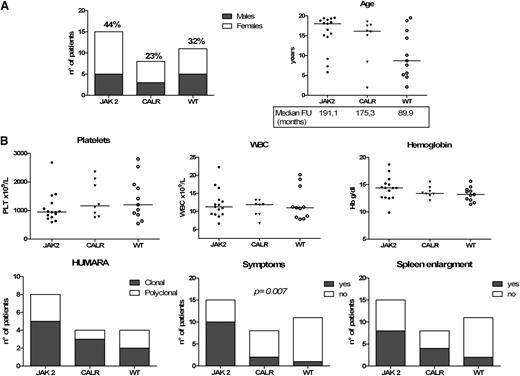To the editor:
After the recent discovery of various mutations of the CALR gene, <10% of adult patients with essential thrombocythemia (ET) or primary myelofibrosis carry no identified molecular markers.1,2 More rarely, ET may occur also in children and adolescents.3 We evaluated, by Sanger sequencing, the mutation status of exon 9 of the CALR gene in 34 ET patients younger than 20 years of age at diagnosis (median age, 15 years; range, 1-19 years). The study was approved by the Institutional Ethic Committees. The median age at diagnosis and the respective follow-up of patients grouped according to their genotype (JAK2V617F mutated, CALR mutated, and wild type for JAK2, CALR, and MPL) are summarized in Figure 1A.
Characteristics of patients grouped according to their genotype. (A) Frequency of different mutations among 34 patients with ET, median age, and median follow-up of each group. (B) Hematologic and clinical findings at diagnosis in each group of patients. Data on clonality of hematopoiesis are relative to the time of molecular testing. Only significant results are shown. CALR, CALR mutated; JAK2, JAK2V617F mutated; WT, wild type for JAK2, CALR, and MPL.
Characteristics of patients grouped according to their genotype. (A) Frequency of different mutations among 34 patients with ET, median age, and median follow-up of each group. (B) Hematologic and clinical findings at diagnosis in each group of patients. Data on clonality of hematopoiesis are relative to the time of molecular testing. Only significant results are shown. CALR, CALR mutated; JAK2, JAK2V617F mutated; WT, wild type for JAK2, CALR, and MPL.
CALR mutations were found in 8 patients, all JAK2 and MPL wild type. On the whole, CALR-mutated ET represented 44% of JAK2 and MPL wild-type ET and 23% of the entire series. This figure is lower than those reported in large series of adult patients, ranging from 67% to 84% of CALR mutations in JAK2- and MPL-negative cases.1,2,4,5 Among the 26 CARL wild-type patients, 15 were JAK2V617F mutated (44% of the entire population), whereas 11 were negative for both JAK2 and MPL mutations (32% of the whole series) (Figure 1A). All CARL mutations observed in our patients have been previously reported.1,2 We found a 5-bp insertion in 3 patients, a 52-bp deletion in 4 patients, and a combined insertion and deletion in 1 patient. The age and hematologic findings at diagnosis were similar among JAK2-mutated, CARL-mutated, or JAK2, CARL, and MPL wild-type patients (P = .166 for age, .875 for white blood cells, .445 for platelets, and .279 for hemoglobin concentration) (Figure 1B). Likewise, no differences were found between JAK2-mutated and CARL-mutated patients. Three of the 4 female patients harboring CALR mutations exhibited a monoclonal hematopoiesis (Figure 1B). Because, in these patients, the DNA samples were obtained several years after the diagnosis (14, 10, and 12 years, respectively), this finding might indicate the progressive expansion of the CALR-mutated clone over the years.
CALR-mutated ET in adults seems to have a rather indolent course.1,2,4,5 In general, children with ET rarely experience thrombosis or evolve to myelofibrosis.6 However, we found that CARL-mutated or wild patients were more frequently asymptomatic at diagnosis in comparison with patients carrying the JAK2 mutation (P = .0079, Figure 1B). On the whole, 2 thrombotic events were recorded, both in patients without JAK2 and CALR mutations. It is noteworthy that the only patient who evolved into a post-ET myelofibrosis was in the CARL-mutated group.
CALR mutations have been recently reported as acquired somatic mutations also among patients with familial ET or primary myelofibrosis.7 Our series of patients included 2 members of the same family, that is, 2 cousins, male and female, diagnosed at the age of 17 and 18 years, respectively. Interestingly, only the female patient exhibited the CALR mutation, suggesting that the common genetic background is the main driver for developing familial myeloproliferative neoplasms.
Authorship
Acknowledgments: This work was supported by Fondi di Ateneo, Progetti D1 2013, Università Cattolica, Rome, Italy.
Contribution: F.G. and L.T. contributed to the study design, enrolled patients, recorded, analyzed, and interpreted data, and wrote the manuscript; S.C., M.M., and D.D. performed molecular analysis; M.L .and D.M. enrolled patients and recorded data; G.P. enrolled patients; L.M.L. coordinated molecular analysis, contributed to the study design, and critically reviewed the manuscript; and R.F. contributed to the study design and critically reviewed the manuscript.
Conflict-of-interest disclosure: The authors declare no competing financial interests.
Correspondence: Luciana Teofili, Istituto di Ematologia, Università Cattolica del Sacro Cuore, Largo Gemelli 8, 00168 Roma, Italy; e-mail: lteofili@rm.unicatt.it.
References
Author notes
F.G. and L.T. contributed equally to the study.
R.F. and L.M.L. share the senior authorship.


This feature is available to Subscribers Only
Sign In or Create an Account Close Modal